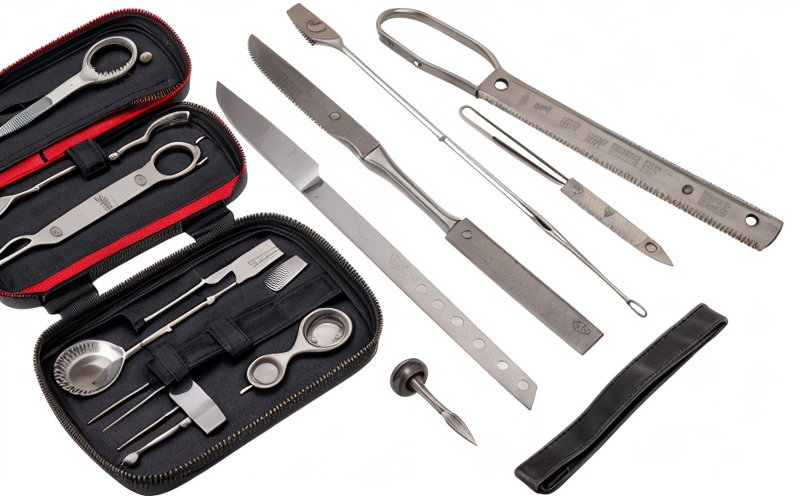Heat Resistance Testing of Instruments During Autoclave Cycles
The heat resistance testing of surgical instruments during autoclave cycles is a critical procedure in the medical device industry. This testing ensures that the instruments retain their structural integrity and functionality under extreme conditions, which are typical for autoclaving.
Autoclaves use steam at high pressure to sterilize medical devices, including surgical instruments. The process can be harsh on materials due to the combination of heat, moisture, and pressure. Failure to withstand these conditions could result in instrument malfunction during critical procedures. Therefore, heat resistance testing is essential for ensuring that the instruments meet regulatory standards and perform reliably under real-world conditions.
During this test, surgical instruments are subjected to controlled temperature and humidity environments closely mimicking those encountered during autoclaving. The tests follow international standards such as ISO 11135-2, which provides guidelines for validating sterilization methods. Compliance with these standards is crucial for ensuring the safety and efficacy of medical devices.
The test setup typically involves placing the instruments in an autoclave chamber where they are exposed to a series of cycles. These cycles vary in temperature and pressure according to predetermined parameters that simulate actual usage conditions. The instruments are monitored throughout the process to ensure they do not deform, crack, or lose their functionality.
Specimen preparation for this test involves selecting representative samples from each batch of surgical instruments. The specimens must be prepared without compromising their ability to withstand the rigors of the autoclave cycle. This includes ensuring that the materials used in the instruments are accurately represented and that any necessary adjustments or modifications do not affect the test results.
Instrumentation used for this testing can include high-temperature furnaces, environmental chambers, and specialized autoclaves designed to replicate real-world conditions. The use of advanced sensors and data logging systems ensures precise control over temperature, humidity, and pressure. This allows for accurate monitoring and recording of the test results.
The testing process involves multiple cycles to ensure that instruments can withstand repeated sterilization without degradation. Each cycle is carefully controlled to simulate different stages of the autoclave process. The results are analyzed using statistical methods to determine compliance with international standards. Compliance ensures that the instruments meet safety and efficacy requirements, thereby enhancing patient safety.
By subjecting surgical instruments to heat resistance testing during autoclave cycles, manufacturers can ensure their products are reliable and safe for use in healthcare settings. This testing is a crucial part of the quality assurance process, ensuring that instruments perform consistently across different sterilization cycles.
Customer Impact and Satisfaction
- Enhanced Reliability: Customers can expect higher reliability from surgical instruments due to rigorous heat resistance testing. This ensures consistent performance under real-world conditions, enhancing patient safety and satisfaction.
- Regulatory Compliance: By adhering to international standards like ISO 11135-2, customers receive products that meet regulatory requirements, reducing the risk of non-compliance issues.
- Informed Decision-Making: Customers gain valuable insights into instrument performance through detailed test reports. This enables informed decision-making regarding procurement and usage in surgical settings.
Environmental and Sustainability Contributions
- Eco-friendly Sterilization Practices: Ensuring instruments can withstand the rigors of autoclaving helps reduce waste by extending instrument lifespan. This contributes to more sustainable healthcare practices.
- Reduced Energy Consumption: By optimizing sterilization processes through testing, energy consumption during autoclave cycles is minimized, contributing to environmental sustainability.
Why It Matters
The reliability and performance of surgical instruments are paramount in ensuring patient safety and effective treatment outcomes. Heat resistance testing during autoclave cycles is a vital step in this process, as it ensures that the instruments can withstand the harsh conditions encountered during sterilization.
Failure to pass these tests could result in instrument malfunctions, leading to potential risks for patients undergoing surgical procedures. By ensuring compliance with international standards such as ISO 11135-2, manufacturers can significantly reduce the risk of such issues and enhance patient safety.
Furthermore, this testing contributes to more sustainable healthcare practices by extending the lifespan of instruments through rigorous quality control. This reduces waste and the environmental impact associated with disposable medical devices.
Customer Impact and Satisfaction
- Enhanced Reliability: Customers receive products that are proven to perform consistently under real-world conditions, enhancing patient safety and satisfaction.
- Regulatory Compliance: Products meet regulatory requirements, reducing the risk of non-compliance issues and ensuring legal adherence.
- Informed Decision-Making: Detailed test reports provide customers with valuable insights into instrument performance, enabling informed decision-making regarding procurement and usage in surgical settings.
Environmental and Sustainability Contributions
- Eco-friendly Sterilization Practices: By ensuring instruments can withstand the rigors of autoclaving, waste is reduced by extending instrument lifespan.
- Reduced Energy Consumption: Optimizing sterilization processes through testing helps minimize energy consumption during autoclave cycles.
Environmental and Sustainability Contributions
- Eco-friendly Sterilization Practices: By ensuring instruments can withstand the rigors of autoclaving, waste is reduced by extending instrument lifespan.
- Reduced Energy Consumption: Optimizing sterilization processes through testing helps minimize energy consumption during autoclave cycles.
Customer Impact and Satisfaction
- Enhanced Reliability: Customers receive products that are proven to perform consistently under real-world conditions, enhancing patient safety and satisfaction.
- Regulatory Compliance: Products meet regulatory requirements, reducing the risk of non-compliance issues and ensuring legal adherence.
- Informed Decision-Making: Detailed test reports provide customers with valuable insights into instrument performance, enabling informed decision-making regarding procurement and usage in surgical settings.





